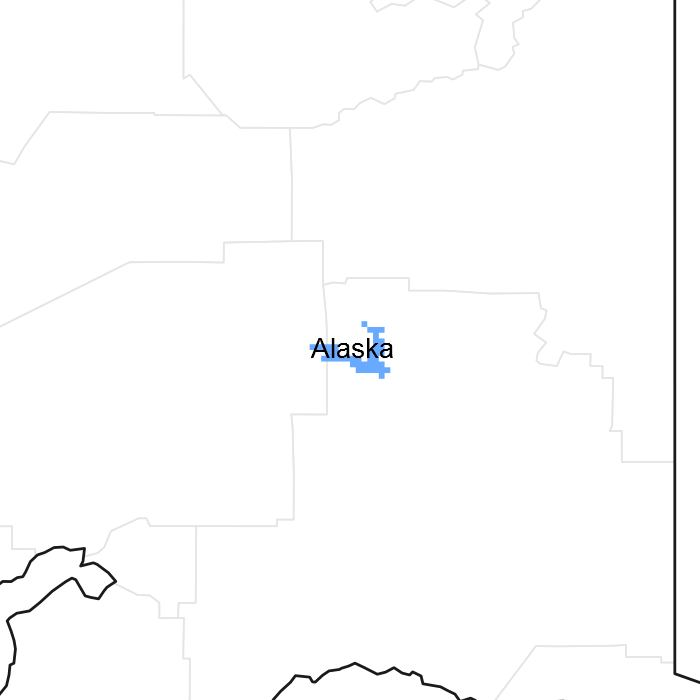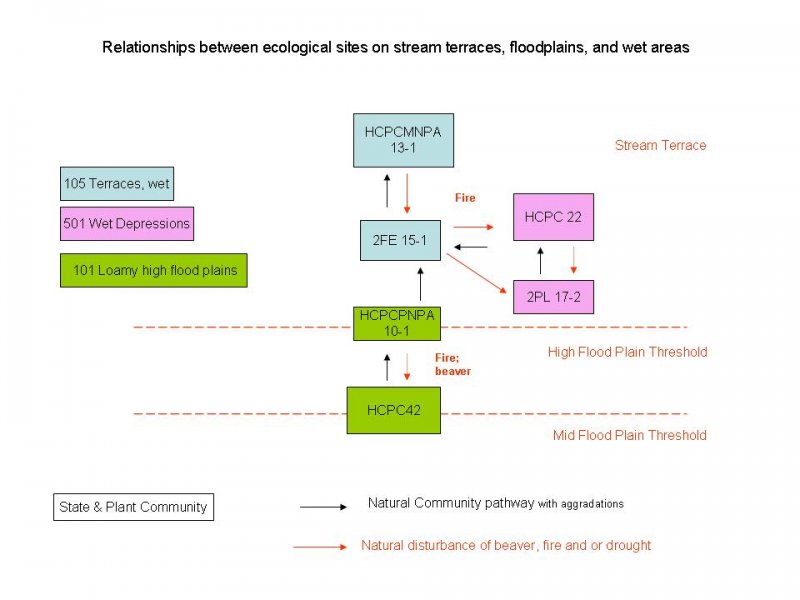Community 1.1
Low Shrub Birch/closed sheath cottongrass scrub
Low shrub birch/closed sheath cottongrass scrub is dominated by moderately dense to dense Eriophorum brachyantherum tussocks, with an open to moderately closed overstory of low and dwarf shrubs and scattered stunted trees and tree regeneration.
Low shrub birch/closed sheath cottongrass scrub is probably late seral vegetation on nearly level and concave sites that have remained undisturbed by wildfire for an extended period of time. In many places, this type is a seral stage leading to Black spruce/ closed sheath cottongrass woodland. Both types are often in association with one another on the same landforms and soils. These two cover types are transitional with one another and often the break between them is arbitrary.
Riparian-Wetland Classification: Palustrine needle-leafed evergreen scrub-shrub, saturated, organic (Cowardin et al. 1979)
Forest overstory. Tree canopy cover ranges from 10 to occasionally 45 percent. In most stands, trees are 10 to 18 feet (3.0 to 5.5 m) in height and 1.5 to 4 inches (4 to 10 cm) in diameter at ground level. Occasional trees up to 35 feet (10.7 m) in height and 6 inches (15 cm) in diameter are in most stands. Tree basal area in Black spruce/closed sheath cottongrass woodland ranges from 5 to 60 feet2/acre (1.1 to 13.8 m2/ha) based on 13 sample stands.
Forest understory. Tussock cover ranges from 25 to 85 percent. In areas of the best development, tussocks range from 9 to 30 inches (23 to 76 cm) in height with spacing between tussocks of 8 to 16 inches (20 to 41 cm). Where tussock development is weaker, other sedges are common among the tussocks. The most frequently occurring sedges are Carex aquatilis and C. lugens.
Canopy cover of the scrub layer typically ranges from 20 to 60 percent. In some stands with weak tussock development, scrub cover occasionally exceeds 75 percent. Important low and dwarf shrubs include Betula glandulosa, Ledum spp., Vaccinium uliginosum, V. vitis-idaea, Salix planifolia, and Andromeda polifolia in some stands. Picea mariana, and to a lesser extent P. glauca, are common in most stands. Trees are usually less than 15 feet (less than 4.6 m) in height and form less than 10 percent canopy cover. Tree regeneration is well-represented in some stands.
Except for Rubus chamaemorus, Petasites frigidus, and Arctagrostis latifolia, other herbs are uncommon in Low shrub birch/closed sheath cottongrass scrub. R. chamaemorus forms a moderately open cover in occasional stands. Throughout Low shrub birch/closed sheath cottongrass scrub, mosses, in particular Sphagnum, cover much of the soil surface, and ponded water and saturated conditions are common between the tussocks.
Table 5. Ground cover
| Tree foliar cover |
1-45%
|
| Shrub/vine/liana foliar cover |
1-65%
|
| Grass/grasslike foliar cover |
1-80%
|
| Forb foliar cover |
1-40%
|
| Non-vascular plants |
1-100%
|
| Biological crusts |
0%
|
| Litter |
1-50%
|
| Surface fragments >0.25" and <=3" |
0%
|
| Surface fragments >3" |
0%
|
| Bedrock |
0%
|
| Water |
0%
|
| Bare ground |
1-7%
|
Table 6. Canopy structure (% cover)
| Height Above Ground (ft) |
Tree |
Shrub/Vine |
Grass/
Grasslike |
Forb |
| <0.5 |
– |
– |
– |
– |
| >0.5 <= 1 |
– |
– |
– |
– |
| >1 <= 2 |
– |
– |
15-75% |
15-75% |
| >2 <= 4.5 |
– |
25-70% |
– |
– |
| >4.5 <= 13 |
10-45% |
– |
– |
– |
| >13 <= 40 |
– |
– |
– |
– |
| >40 <= 80 |
– |
– |
– |
– |
| >80 <= 120 |
– |
– |
– |
– |
| >120 |
– |
– |
– |
– |
| Jan |
Feb |
Mar |
Apr |
May |
Jun |
Jul |
Aug |
Sep |
Oct |
Nov |
Dec |
| J |
F |
M |
A |
M |
J |
J |
A |
S |
O |
N |
D |
Community 2.1
Black spruce/closed sheath cottongrass woodland
Black Spruce/closed sheath cottongrass woodland is the correlated PNC on this site.
Black spruce/closed sheath cottongrass woodland consists of woodland to open stands of stunted, small diameter Picea mariana.
Black spruce/closed sheath cottongrass woodland is late seral vegetation on nearly level to concave sites that have remained undisturbed by wildfire for an extended period of time. This type is usually in association with Low shrub birch/closed sheath cottongrass scrub. These two cover types are transitional with one another and often the break between them is arbitrary.
Riparian-Wetland Status
Classification: Palustrine needle-leafed evergreen scrub-shrub, saturated, organic (Cowardin et al. 1979)
Forest overstory. Tree canopy cover ranges from 10 to occasionally 45 percent. In most stands, trees are 10 to 18 feet (3.0 to 5.5 m) in height and 1.5 to 4 inches (4 to 10 cm) in diameter at ground level. Occasional trees up to 35 feet (10.7 m) in height and 6 inches (15 cm) in diameter are in most stands. Tree basal area in Black spruce/closed sheath cottongrass woodland ranges from 5 to 60 feet2/acre (1.1 to 13.8 m2/ha) based on 13 sample stands.
Forest understory. Eriophorum brachyantherum tussocks, intermixed with a variety of sedges and low and dwarf shrubs, characterize the understory. In areas of strong tussock development, tussocks range from 9 to 24 inches (23 to 61 cm) in height with spacing between of 8 to 16 inches (20 to 41 cm), and shrubs and other herbs are uncommon. Where tussock development is weaker, low and dwarf shrubs and other sedges codominate. The most frequently occurring sedges are Carex aquatilis in wetter microsites and C. lugens on higher microsites. Important low and dwarf shrubs include Ledum spp., Vaccinium uliginosum, Betula glandulosa, V. vitis-idaea, Salix planifolia, and Empetrum nigrum. Except for Rubus chamaemorus and Petasites frigidus, other herbs are uncommon. R. chamaemorus forms a moderately open cover in occasional stands. Throughout Black spruce/closed sheath cottongrass woodland, mosses, and in particular Sphagnum, cover much of the soil surface and ponded water and saturated conditions are common between the tussocks.
Setting
Distribution and extent: widely distributed throughout the uplands and River corridor; moderate extent
Elevation: 1,850 to 3,000 feet (564 to 914 m)
Landforms: nearly level to occasionally moderately sloping lacustrine terraces and level stream terraces
Principal soils: Kuslinad, very wet; Klasi, very wet; Mendna, very wet; Pergelic Cryohemists; and Haggard (The thickness of the surface organic mat ranges from 8 to 25 inches [20 to 64 cm] in most stands.)
Table 7. Ground cover
| Tree foliar cover |
40%
|
| Shrub/vine/liana foliar cover |
5-30%
|
| Grass/grasslike foliar cover |
1-55%
|
| Forb foliar cover |
1-2%
|
| Non-vascular plants |
5-60%
|
| Biological crusts |
0%
|
| Litter |
10%
|
| Surface fragments >0.25" and <=3" |
0%
|
| Surface fragments >3" |
0%
|
| Bedrock |
0%
|
| Water |
0%
|
| Bare ground |
0%
|
| Jan |
Feb |
Mar |
Apr |
May |
Jun |
Jul |
Aug |
Sep |
Oct |
Nov |
Dec |
| J |
F |
M |
A |
M |
J |
J |
A |
S |
O |
N |
D |


